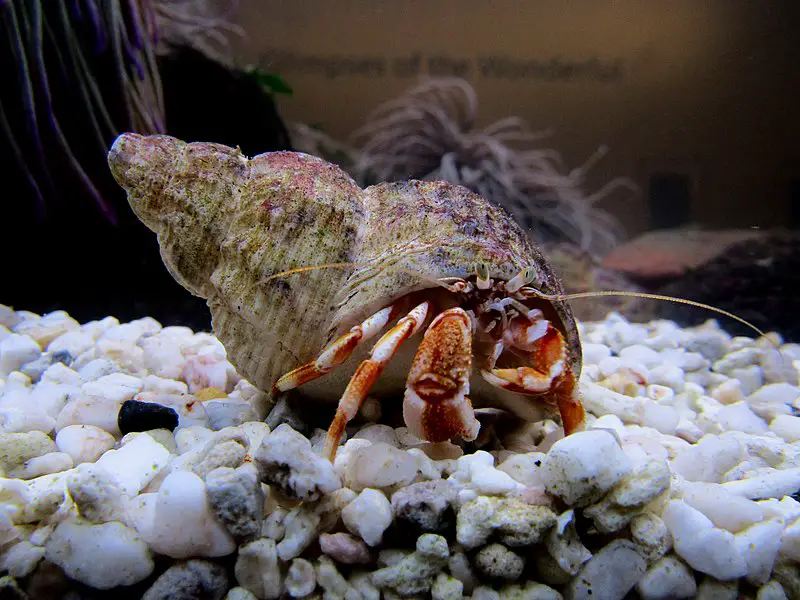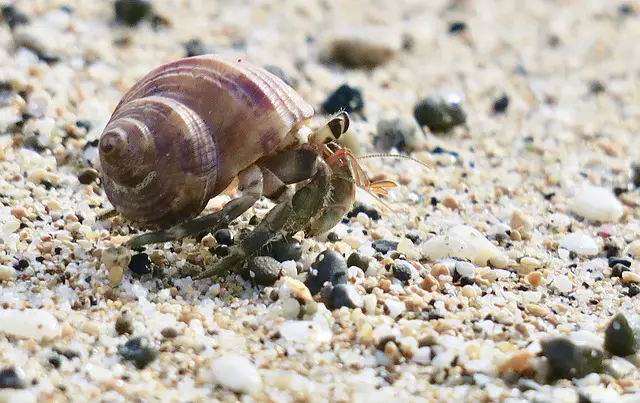Some non-reef safe hermit crabs include the fascinating Halloween hermit! As amazing as they are to look at and fascinating to watch, sadly, not all hermit crabs are reef safe. Some will attack and eat the living things around the reef, which obviously makes them the worst kind of tank mates!
That being said, there are also plenty of hermit crabs that are fine in reef tanks and, in fact, even beneficial to them. They can help to maintain the tank by controlling some growths and will make a beautiful addition.
Some of the worst hermit crabs for reef tanks include the Anemone Carrying Hermit, the Halloween hermit, the Yellow Hairy hermit, the striped hermit crab, and so on. These kinds of crabs can easily damage the reefs due to their size, weight, and fighting and eating habits!
Therefore, you should stick to housing reef safe crabs such as the dwarf blue leg, the dwarf red tip, the dwarf yellow tip, the dwarf zebra, the polka dot, the electric orange, and the scarlet reef hermit crabs. These species typically feed on the algae and debris in the tanks, often helping to maintain and keep them clean.
Will hermit crabs eat starfish?
Although it isn’t common, some hermit crabs have indeed been found to eat starfish. Although starfish are not their typical meal of choice, even a hermit crab will eat one in certain situations! They usually only eat starfish if nothing else is around to snack on. If a hermit crab is starving, then they will opt for whatever prey they can, including starfish.
Starfish are relatively easy to kill as they cannot fight. Therefore, the hermit crab can easily catch them and even eat them alive. But what about reef safe hermit crabs?
Generally speaking, reef safe hermit crabs will not eat starfish. They should have plenty to eat from the reef and from what you are feeding them. They also do not tend to be aggressive creatures and are more likely to help to maintain the tank rather than disrupt it!
Therefore, if you do want to keep starfish in your reef tank, as long as you have reef safe hermit crabs, then they should be perfectly safe. Remember to keep them all well-fed to avoid any eating between them, just in case!
Will hermit crabs eat snails?
Hermit crabs are known for eating snails, both in the wild and in reef tanks. Even reef safe hermit crabs will occasionally eat snails. But why do they eat them, and how can you prevent it?
Hermit crabs will eat snails for one of two reasons. First, they will eat snails if they are particularly hungry! If they are not getting the sustenance that they need, then they are bound to eat what they can access, and that includes live snails around them.
They will also eat snails if they can smell that one is dying or even dead. In many ways, this is an excellent way of maintaining the tank! But, there is a way you can stop your crabs from chowing down on your snails.
One of the best ways of ensuring that your reef safe hermit crabs do not eat your snails is by ensuring your snails are big enough to pose a threat! The bigger the snails are, the better the chance they will have against a hermit crab.
However, you will need to ensure that the snail is not too big for the reef and that all the creatures within the reef tank have plenty of room! Then, you will simply need to ensure that they have plenty of food and shells. As long as the two are not competing for shells or food, then they can live perfectly happy together.
Will hermit crabs eat coral?
Yes, even reef safe hermit crabs will eat coral. However, it is not necessarily a bad thing! In fact, having hermit crabs in your reef tank can be a great way of maintaining the coral.
Reef safe hermit crabs are known as being detritivores. That means that they eat dead or decaying matter that they can find on the coral reef. This does indeed include some corals itself! While other hermit crabs also eat the algae on the reef, helping to control it as it grows.
Either way, reef safe hermit crabs are incredibly useful in reef tanks. By consuming the dead and decaying matter, the coral can grow stronger. They work similarly to earthworms in the groundwork to maintain the soil. Moreover, by eating the algae, which can grow very quickly, the hermit crabs are helping to maintain the quality of the environment within the reef tank.
Where are hermit crabs’ mouths?
A hermit crab’s mouth is located beneath its eyes and antenna. Despite what good eaters they are, hermit crabs do not have mouths in the traditional sense that you might see them. In fact, it can be quite difficult to locate a hermit crab’s mouth!
However, it does not have lips that can simply wrap around the food. Instead, the hermit crab uses its various claws to break down the food, making it as small as it needs it to be to go directly into its mouth before being digested.
In a way, they use their claws as we use our fingers to break down some of our food. Then, they pass the food from each claw to a smaller pair of softer limbs next to their mouths, which they use to carry the food into their mouths. Their mouths are mandibles.
It is very impressive to watch them eat, so if you do have a hermit crab in your tank, then do take the time to observe them! Hermit crabs are odd creatures to behold initially, as it can seem as though they don’t eat or poop properly – but trust us when we say that they do!


